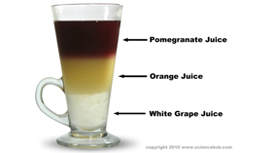

Density is a fascinating and sometimes tricky idea to understand. This Drink of Density will help bring home the idea of density in liquids, not to mention it looks cool when your all done, it’s tasty, and it’s even good for you – what more could you ask for in a science activity!
YOU WILL NEED:
WHAT TO DO:
1. Before you begin, you can guess which juices you think will be more dense and form a hypothesis of how the levels of your Drink of Density will turn out. Check the number of ingredients, the sugar content, and the water content to help you out.
2. In order to display your density levels, you will need to find out which of your juices are the most and least dense. Pour one of your juices into the narrow glass to fill it about 1 inch (2.5 cm) high. Fill a dropper with another juice and slowly drop it onto the inside of the glass so that it runs down the side of the glass. Watch the juice to see if it goes below or above the juice in there. (if it simply mixes with the juice and does not go above or below, it has the same density as the juice and you will need to move on to your next juice.
3. Continue experimenting with other juices to determine which juices go to the bottom (more dense) and which ones go to the top (least dense.)
4. Once you have the densities determined, start over with a clean glass and use the dropper for each level to create your final Drink of Density!
Note: In case you were wondering, the juices in the photo are (top) Tropicana Pomegranate-Blueberry, (middle) Tropicana Pure Premium Orange Juice, (bottom) Nature’s Promise White Grape (33 grams of sugar in 6.75 ounces!)
HOW DOES IT WORK?:
The density of liquids demonstrates the amount of “stuff” (atoms, mass) that are present in a particular volume of the juice. In other words, if you have cup with 200ml of plain water, and a cup with 200 ml of water that has lots of sugar dissolved in it, the cup of sugar water will be heavier even though they are the same volume of liquid – the invisible sugar molecules are dispersed in the water, making it heavier (more dense.)
Source: Science BoB
Regd. Office :
Vikram Sarabhai Science Park, Plot No. 10/870,Thengode P.O
Kakkanad,Kochi -30, Mob: +91 9745377791, 8943233388
E-mail: info@vssf.in, spotnational@vssf.in
Terms of Use | Privacy Policy | Contact Us
© 2026 www.vssf.in All Rights Reserved
Designed and Developed by websoultechserve.com